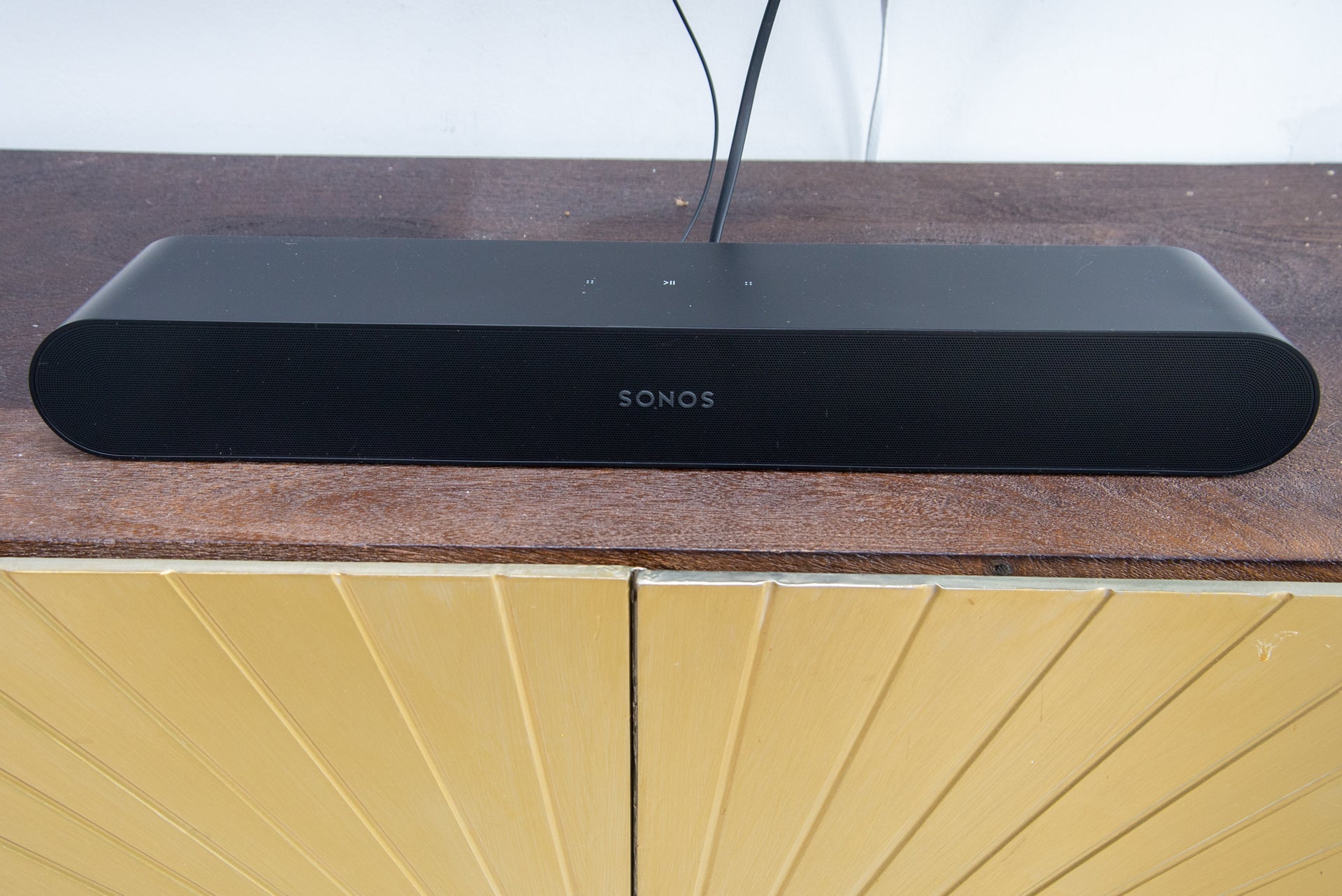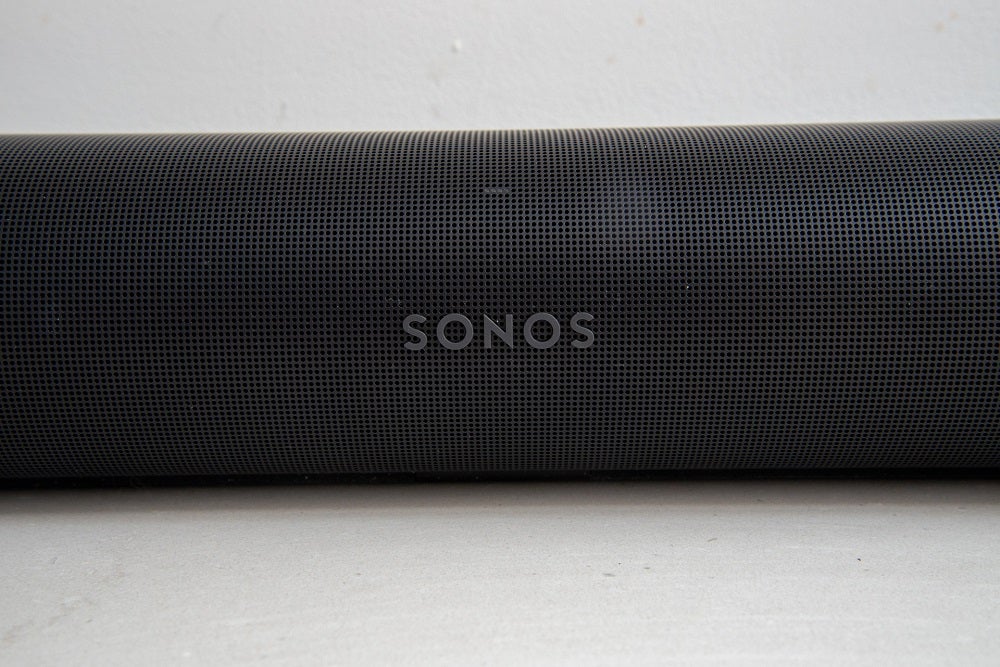Verdict
Simpler, cheaper and smaller than the other soundbars in the Sonos range, the Sonos Ray is built with one main job in mind: making poor-quality TVs sound better. This is a more straightforward soundbar than its stablemates, with optical input only, and no 3D sound formats. However, it supports 5.1 audio, cleanly delivering content from quiz shows to action movies with a fair amount of bass and presence. Plus, it’s a fully featured multiroom audio speaker, performing well for music, too. For smaller rooms or secondary TVs, the Ray is a neat buy.
Pros
- Clean and powerful TV audio
- Surprising amount of bass
- Wide soundstage
- Optional surround sound
Cons
- Remote setup can be fiddly
- Better at TV than music
Availability
- UKRRP: £279
- USARRP: $279
- EuropeRRP: €298
-
TrueplaySonos Trueplay automatically tunes the soundbar for where you’re sitting and the size and shape of your room -
Surround soundIt supports 5.1 Dolby Digital and DTS soundtracks, and you can upgrade by adding rear speakers or the Sonos Sub for extra bass -
OpticalThe soundbar uses an optical connection from your TV for sound
Introduction
Not everyone wants to spend a fortune on a soundbar that supports the latest audio formats. For those who just want improved sound, there’s the Sonos Ray.
If there’s one thing the majority of TV watchers can generally agree upon, it’s that most TVs offer poor-quality sound, to the point where everything, particularly speech, is delivered as an indistinct mess.
Officially the smallest and cheapest Sonos soundbar, the Ray goes back to basics: there’s no HDMI input (you get optical) and no microphones, so this isn’t a smart speaker. However, it isn’t about what you don’t get; it’s about what the Ray can deliver to make your TV sound better.
Design
- Compact and thin
- Touch controls on top
- Optical input at the rear
The Ray is different to the other Sonos soundbars, and so it looks a little different, too. While the Beam’s front wraps around to the back, the Ray has curved ends; it’s lozenge-shaped, with the sides tapering away to the back.
It’s a less in-your-face design, which means the Ray is able to blend in a bit more with its surroundings. As usual, there are black and white versions available.
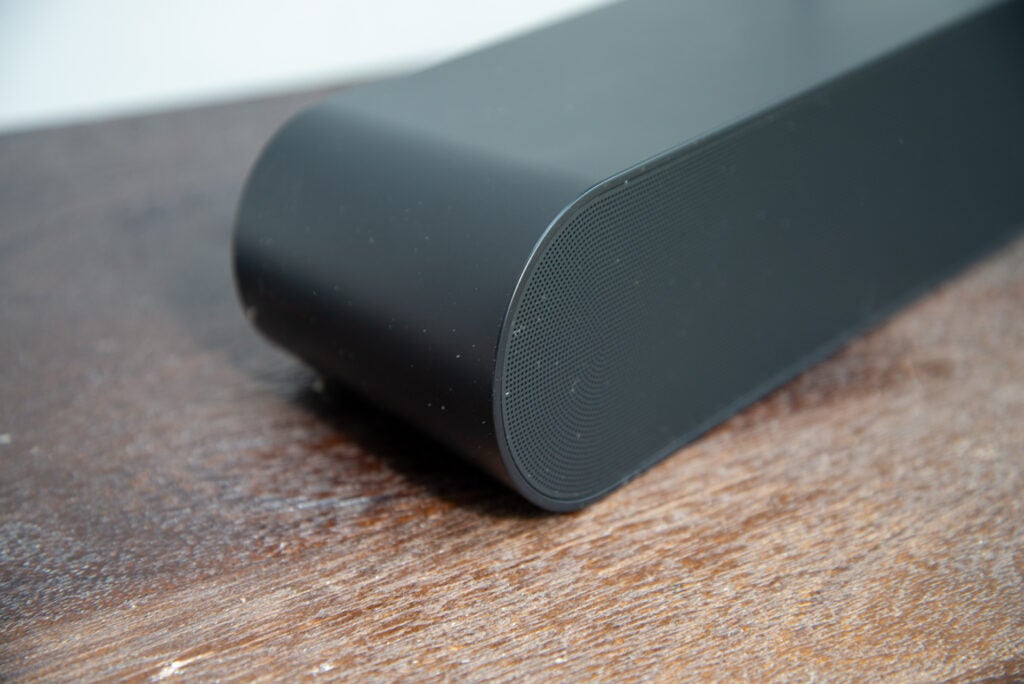
Officially, the Ray is the smallest soundbar Sonos has ever made at 71 x 559 x 95mm; the Sonos Beam is only a fraction bigger at 69 x 651 x 100mm. At this kind of size, the Ray is useful for TVs up to a maximum of 55-inches.
Although the Ray can sit on a unit in front of your TV, it also has brackets at the rear that take the (optional) official mount.
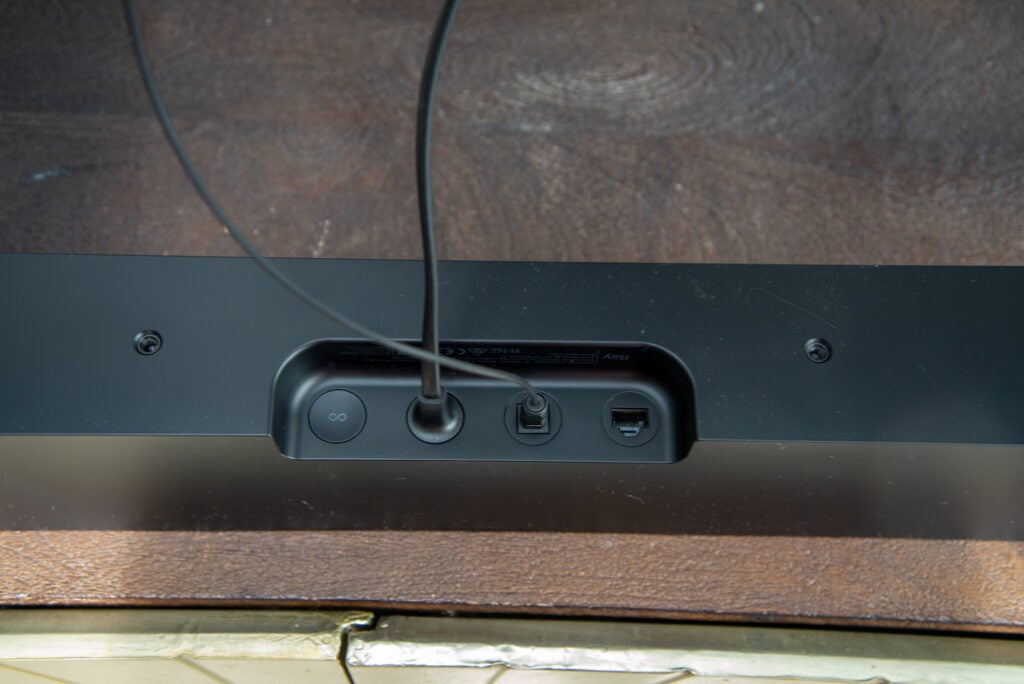

There’s no HDMI with this model – only an optical S/PDIF input at the rear, with a cable in the box. You can connect the Ray directly to your TV (pretty much every model I’ve seen has the output); but most set-top boxes tend to have an optical output if you’d rather bypass this option. Then, there’s just a power cable in the box, which plugs in next to the optical input.


As with other Sonos players, the touch controls on top also act as track-skip and volume control buttons.
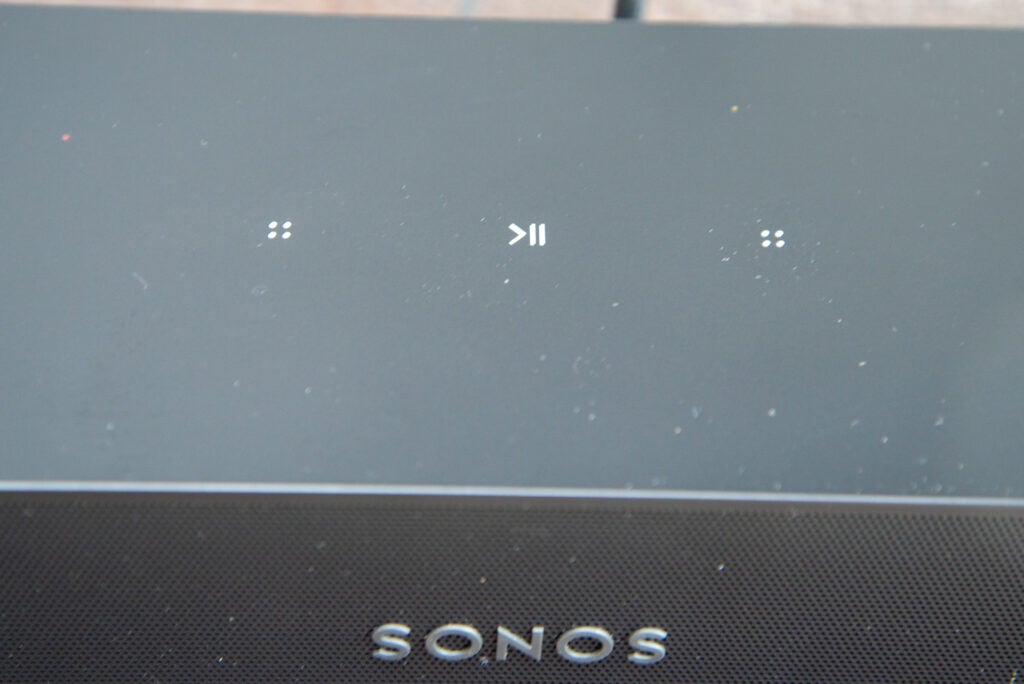

Features
- IR Receiver
- Trueplay compatible
- Dolby and DTS support
Sonos has streamlined the setup of its players; the Beam, for example, is super-easy to get working. It has to be installed into an S2 system, with no support for S1. I found that firing up my Sonos app was enough to have the Ray detected automatically, and then a quick setup wizard took me through the connection steps to get the soundbar onto my home system.
Sonos then runs through the Trueplay configuration to tune the soundbar to your room. As it is with the Arc and Beam, this is a two-step process. The first had me sit where I’d normally watch TV to tune TV audio; the second step was the “normal” Trueplay option, where I had to walk around waving my phone up and down.
The good thing about using optical S/PDIF is that it generally just works. With the HDMI-based Arc and Beam, they won’t necessarily function out of the box, and on occasion there’s some faff and rebooting of devices involved.
With my TV, the optical connection worked immediately. Well, to a point. For some reason, there’s no setting to turn off the TV’s speakers when optical is connected, so audio was coming out of both my TV and the Ray. I got around this by turning down the volume on the TV all the way.
Since the Ray has an IR input, you can tune it so that your TV’s remote control will operate volume on the soundbar. There’s a setup routine for this, although the Sonos app indicated that it hadn’t detected an IR signal, even though the status light on the Ray was flashing.
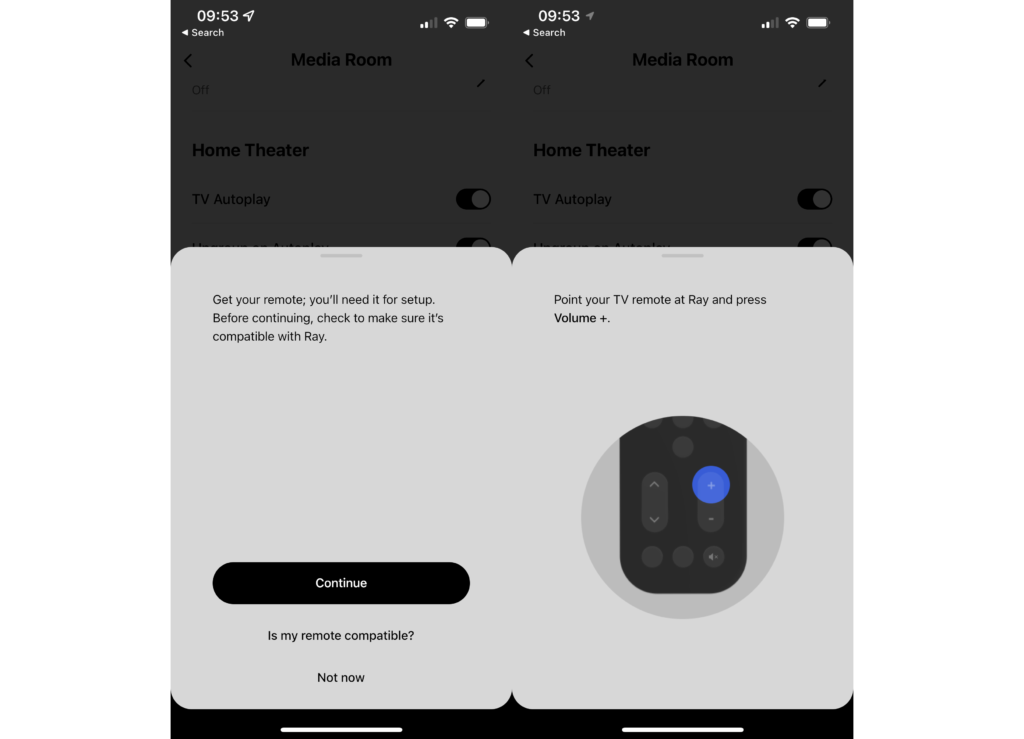

It turns out that the JVC TV that I was using for testing uses Toggle Bit for its remote controls. In other words, when you hit the same button twice, the remote sends a different signal for each, alternating between two IR codes. The workaround was to follow the Sonos setup routine; but after every requested button press, I covered the remote’s IR sensor and hit the button again before continuing with the wizard.
This managed to get the remote working, but I found that I often had to hit the volume buttons twice to get the Ray to respond.
I had the additional problem that my TV refused to turn off its speakers, so using the remote control to turn up volume performed the same action on the TV and the soundbar.
As I was using a Sky Q Mini box plugged into the TV, I went into the Sky menu and reprogrammed the remote control to function with Sonos devices, which worked perfectly. This proved a better solution for me.
A nice update is that the Sonos app now shows you which sound format you’re getting. Initially, my app stated that I was getting stereo PCM sound for everything rather than Dolby Digital; I had to change the digital output on my TV from PCM to compressed in order to pass on a 5.1 signal.
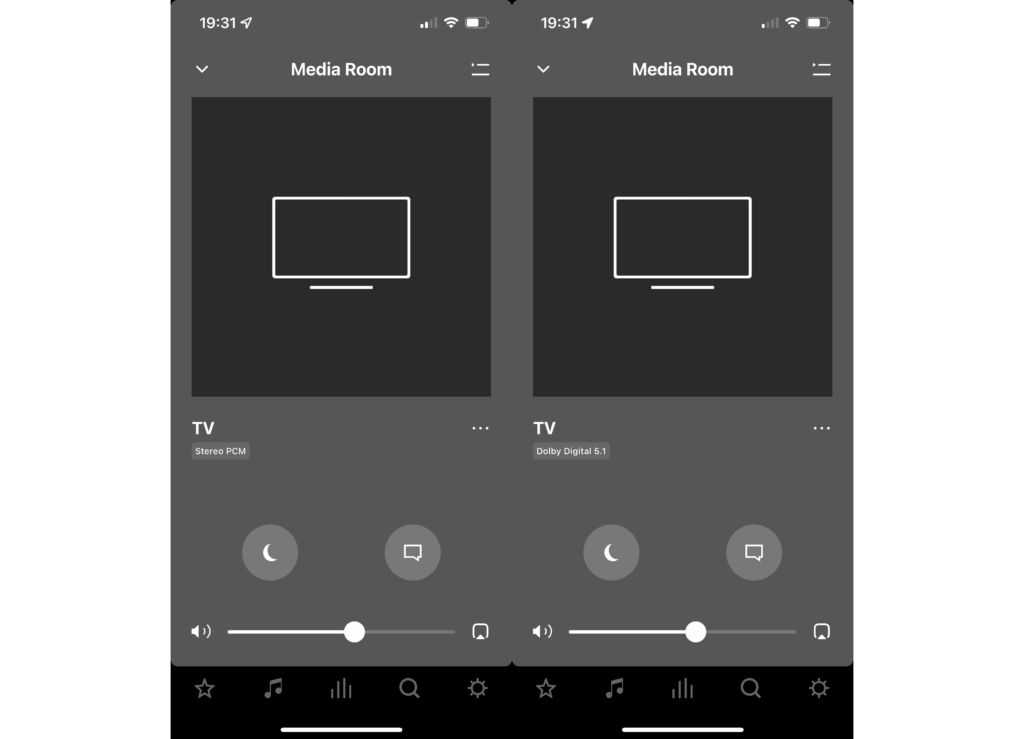

Here, we run into the limitation of the soundbar: an optical connection has only enough bandwidth for regular Dolby Digital (and DTS), not Dolby Digital Plus or Dolby TrueHD. That means no Atmos support – not that this soundbar has any upward-firing speakers to take advantage.
Does it matter? Well, for the majority of folk, no. Regular Dolby Digital still sounds great, even if it isn’t quite as clean and detailed as its higher-end codec siblings. For the intended audience and maximum compatibility, Dolby Digital is good enough.
It’s worth diving into the settings and turning on TV Autoplay, which will pump sound from your TV to the Ray when you turn it on, stopping any music that’s playing.
Of course, the Ray also acts as a fully fledged music player, just like any other Sonos device. Via the app, pretty much every single major music service is supported – including Spotify, Apple Music, Tidal and Deezer. Plus, there’s AirPlay 2 support for direct streaming.
There’s still nothing as good as Sonos for multiroom support: the app makes it so easy to connect and disconnect rooms. And don’t forget that it delivers one major advantage over the competition: with a single streaming account, you can play different tracks in different rooms at the same time.
There are no microphones on this soundbar, so there’s no option to set up Amazon Alexa, Google Assistant or even the new Sonos Voice Control system. Still, if you want that, you can set up the relevant Skills and control Sonos through your Amazon or Google Smart Speakers.
Sound Quality
- Surprisingly wide soundscape
- Effective bass
Internally, the Sonos Ray has four Class-D amplifiers controlling two tweeters, two full-range mid-woofers, and it has two curved low-velocity ports for bass. There are also waveguides flanking the left and right speakers, pushing audio out wide. Sonos, as normal, doesn’t quote the exact specs for its products.
Designed to boost the frequency of speech, the Ray does an admirable job with basic TV. Quiz shows, the news, documentaries and the like all sounded better, with the soundbar making the audio track much easier to understand. Compared to my slightly muffled TV, the improvement is clear and obvious. And, that’s as true at lower volumes as it is with the sound turned right up.
There’s an optional Speech Enhancement option in the app, which boosts the frequencies of voices. It works well without distorting the rest of the soundtrack, although I didn’t feel as though I needed to turn it on.
If you’re watching at night, the Night Sound option is useful. This boosts quiet sounds and limits loud sounds, so you can watch on lower volumes, and still hear what’s going on without waking the rest of the people in your home.
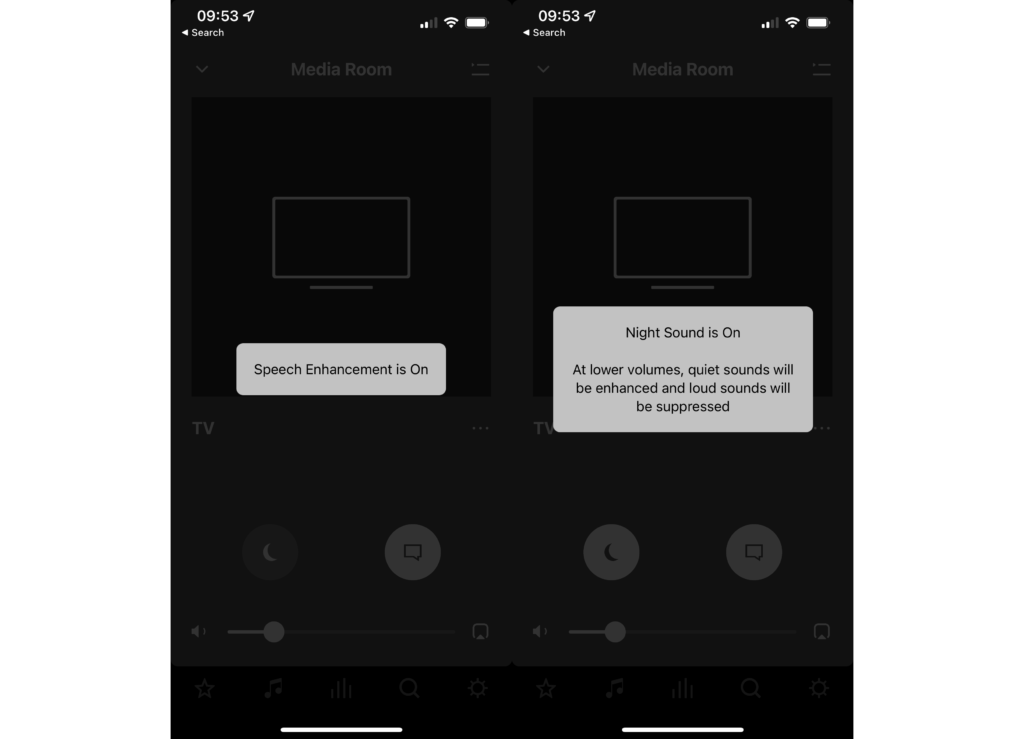

Diving into films, I fired up Captain Marvel. Most noticeable is that bass is pretty good. With the laser fire and explosions in the opening scene, there’s a definite low-frequency boom and a warmth to the effects, even if it isn’t quite as room-shattering as the Arc’s response.
There’s a good degree of wideness to the soundscape. The Ray fills the room nicely, pushing audio out sideways; but sound still feels as though it’s coming from in front of the TV.
With the Beam and an Atmos soundtrack, audio wrapped around me, delivering height and a wall of sound. That simply isn’t possible with the audio layout and supported codecs here. As a device that’s designed to boost TV audio, the Ray fulfills its job, and a bar this small shouldn’t really be able to deliver the low-frequency hit that it can do.
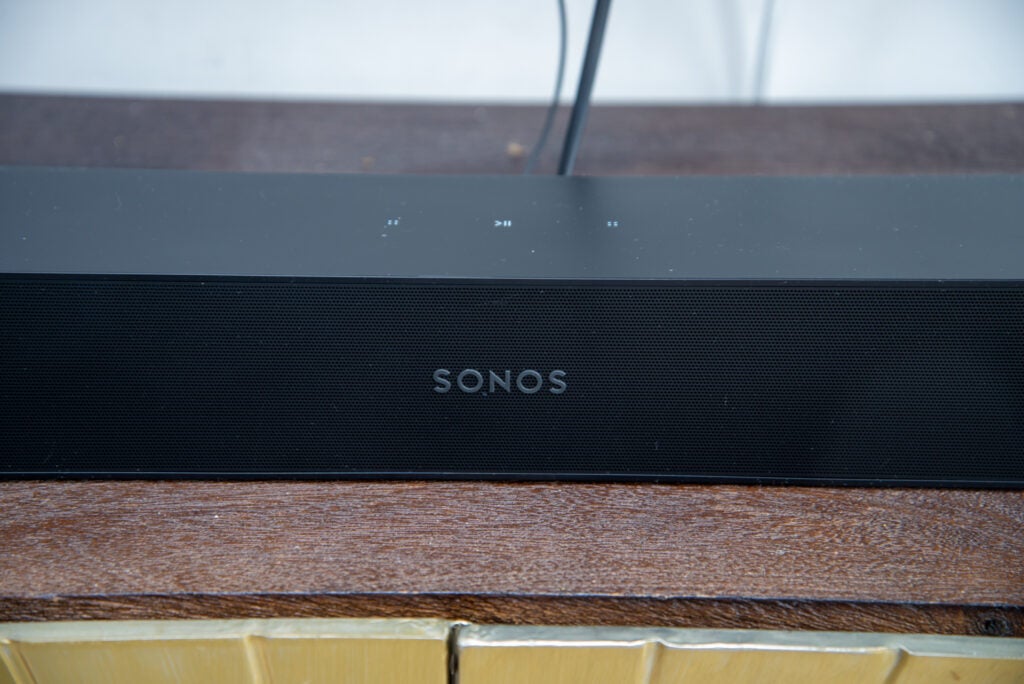

As with other Sonos soundbars, the Ray can have stereo speakers added. I tried it with two Sonos One SL speakers. These deliver true surround sound, with a gentle crossover. The listening field is better, with proper positional sound from in front and behind.
It’s possible to add a Sonos sub into the mix. I have a unit, and Sonos does a brilliant job of tuning the two speakers so that the crossover is spot on. With the sub you get proper room-shaking bass; but since the subwoofer costs double the soundbar, it feels like overkill as an upgrade. The Sonos Sub Mini is a much better partner for the Ray.
Moving to music, and the Ray puts in a good shift, although it isn’t as good as a Sonos Five or even the Arc or Beam. The Ray copes well at all volumes, and won’t distort at maximum volume. That’s even when playing something bass-heavy, such as OK Go’s This Too Shall Pass.
Classical music sounds decent, with The Imperial March delivered with its initial menace and then mid-track subtlety.
With Rage Against the Machine’s Bombtrack, the Ray handles the intro well and kicks into life when the drums bounce in. Bass isn’t quite as impressive here, with some of the attack and energy lost, but the overall effect is good.
Put on something more subtle, such as Johnny Cash’s Hurt, and the Ray copes well. It doesn’t quite bring out the full detail, such as Cash’s fingers sliding down his guitar strings, but the sound is balanced and poised. Overall, music is a little flatter than through the brand’s other products, although there remains enough power to fill a room – and nothing sounds flat-out bad.
Latest deals
Should you buy it?
For a smaller TV
If you have a smaller or secondary TV with poor-quality sound, the Sonos Ray will provide a boost, delivering a full-on multi-room audio experience.
If you want premium sound
If you want the latest sound formats, such as Dolby Atmos, and a full cinematic experience, the Beam or Arc make for a better choice.
Final Thoughts
With many of the best soundbars aimed at the enthusiast market wanting the best home cinema sound, the Sonos Ray is a refreshing choice for smaller TVs and rooms, where you just want to boost sound quality.
For its primary job, the Ray does a brilliant job: audio is far clearer, while soundtracks and effects sound more dynamic and engaging. Plus, there’s a fair amount of warmth and bass that I wouldn’t necessarily have expected from a device of this size. Bass is usually a weakness on cheaper soundbars.
Music quality is decent from this speaker, and the Ray has the advantage over rivals in that it can be a full-on multi-room player in, arguably, the best system there is. I did find that for music, the quality wasn’t quite as good as for TV and film; but nothing sounded poor – it’s just that Sonos makes some better music players.
For a secondary setup, such as in a bedroom or kitchen, the Sonos Ray is a great upgrade to a TV with poor-quality sound.
How we test
We test every soundbar we review thoroughly over an extended period of time. We use industry standard tests to compare features properly. We’ll always tell you what we find. We never, ever, accept money to review a product.
Find out more about how we test in our ethics policy.
Tested over the course of several days
Tested with real world use and different TVs
Tested with lossy and lossless audio formats
FAQs
It has an optical S/PDIF input only.
It can use Dolby Digital, DTS and stereo PCM.
No, it doesn’t have the necessary speakers, plus the optical input limits the sound formats that can be used.
UK RRP
USA RRP
EU RRP
Manufacturer
Size (Dimensions)
Weight
ASIN
Release Date
First Reviewed Date
Model Number
Sound Bar Channels
Driver (s)
Connectivity
ARC/eARC
Colours
Audio Formats
Rear Speaker
Multiroom
›
Jargon buster
Sonos TruePlay
Trueplay is Sonos’ audio calibration technology that measures how sounds reflect off surfaces in a room and tunes a speaker to deliver the best possible sound.
AirPlay 2
AirPlay 2 is the second generation of Apple’s proprietary wireless streaming tech, which is built into all of its hardware products (and supported by many others). It’s designed to pass content from your Apple device – music, video and photos – to a compatible receiver over your Wi-Fi network such as a TV, wireless speaker, AV receiver etc.
